<French: Click here><Japanese: Click here>
The first step of creating a theater play is a period of experimentation and research to find a way to create interesting images on stage. What I particularly love about SPAC is that everyone participates in the search for ideas. Some elements were imposed from the beginning by the artistic director through the stage directions in the text; however, the actors have a great deal of freedom in making scenic proposals. Everyone contributed their own ideas, bringing inspirations from their personal imagination and interests. For example, Sayaka Watanabe shared her passion for idol dances with us. She suggested that the monkeys perform fan dances for their leader to show their support. She even taught us a few dances, and it was fascinating to learn more about this world, which I wasn’t very familiar with.
At SPAC, the goal is not to simply use again techniques that have proven effective in the past but to always strive to experiment with new things. Many theater companies do not truly reinvent their aesthetics because maintaining a consistent style helps retain audiences and ensures their success and financial stability. This is nothing new: for example, in ancient Roman theater, performances often followed the same structure and used the same character archetypes. Audiences enjoyed seeing something familiar, and the pleasure came from subtle variations. The audience’s enjoyment was essential for the proper execution of the religious ritual. The performance was an offering to the gods, but if the audience did not enjoy the play, they could not share that moment of pleasure and entertainment with them, preventing the connection between the human world and the celestial world from forming. As a result, this theater became fixed within the conventions of audience expectations, and over time, people lost interest, leading to its near-complete disappearance in Europe (or its survival in only anecdotal forms) until the 13th century. This period is often referred to as the “theater’s night.” That is why I believe that experimentation is fundamental. Only by exploring new possibilities we can allow theater to live and evolve. SPAC has the courage to look beyond its past creations, and in this, I see a model to follow for my future productions.
Thus, when representing the sea, we thought of a different way to bring it to life—one that had never been done before at SPAC. Waving a large piece of fabric, placing a blue square on the ground, or putting water on the stage had already been explored.
To start, we all presented references that reminded us of the sea. I was pleasantly surprised by the variety of references proposed by everyone: images, postcards, manga, picture books, anime openings, theme park maps, etc.
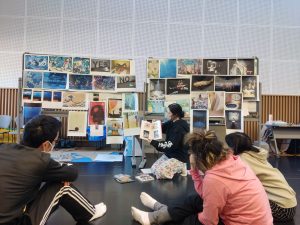
After gathering all the ideas and suggestions, the “sea team” (the name given to the group of actors in charge of researching how to represent the sea) created a multitude of concepts. They thought that instead of using a set design to create a subjective impression of the sea, they could use each performer’s body to form this image. Each actor would embody a wave, and by placing them next to each other, they could create the sea. But how does one become a wave?
Among the suggestions, I found Yuya Daidomumon’s idea particularly amusing—he wanted to imitate a wave using a blue plastic bag with white gloves to symbolize the foam.
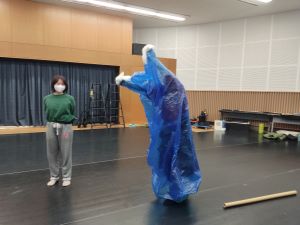
In the end, the sea team decided to use bamboo poles to represent waves. This was a surprising choice due to its originality, pushing the boundaries of imagination. Personally, I would never have thought to represent the sea using straight, rigid pieces of wood. I absolutely love this idea, and I can only call it pure genius.
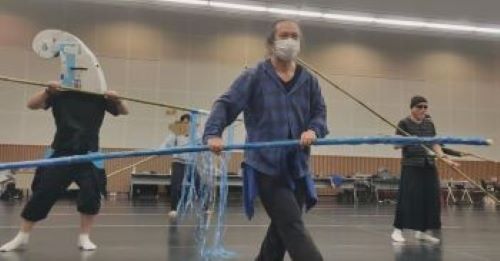
They then added small extra elements to enhance the image of the sea, such as fish necklaces, a boat and a wave mask, and swimming goggles. These proposals are among the funniest things I have seen since the beginning of my stay!
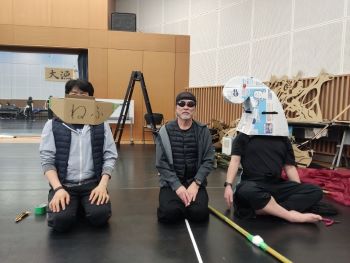
Since the sea team was the same as the team responsible for the great bird Jatayu, they came up with a similar idea for the staging. They needed to represent a gigantic bird that would take up almost the entire stage.
The first idea they had was to make each actor’s body a feather forming the bird’s body. The idea was good; however, the image was not convincing enough. So, they came up with two proposals. The first was to create a gigantic puppet using pieces of fabric. This proposal presented a majestic bird, but it was far too fluid for its state at that moment in the play. Additionally, since the performance will take place outdoors, the wind would have made handling the puppet difficult.
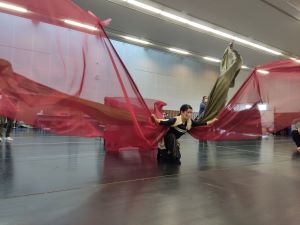
The second proposal was to keep the actors as the feathers of the bird but have them wear cardboard wings to better outline its giant wings. This idea resulted in a stunning and impressive visual. Having tried the manipulation myself, I can say that the challenge lies in coordination and group awareness.

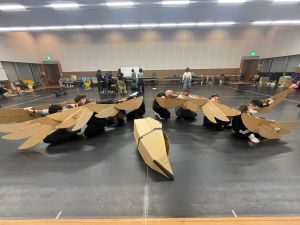
However, there is a feeling of being united together within the same body, and with practice, coordination becomes more and more natural as we truly connect with one another. It was an interesting experience for me because, even though I struggled to understand what they wanted to achieve when they explained it in Japanese, I understood everything once I became a feather of the bird. It felt as if we were forming a chain: the person behind me would pass on the energy of their movement, and I would then transmit it to the person after me.
I wonder if, had I spoken Japanese as fluently as they did, it would have been more difficult for me to create this connection through body movement and energy. Indeed, I think that if my Japanese were perfect, my movement would have been more of a response to verbal instructions rather than a true instinctive gesture generated by my connection with the group. I am considering repeating this experience in French or later when my Japanese improves.
In the story of the Ramayana, Prince Rama is aided by magical monkeys. These monkeys play a significant role in the story; as a result, the movers quickly became interested in how to represent them. However, I was surprised to see that the approach was reversed compared to what I had seen in France.
In France, most of the time, the text and the psychology of the characters are worked on before their postures and gestures. At SPAC, the experiments began with research on the body in space: how could the monkeys of the Ramayana move and live as a group?
At first, the goal was not to exactly replicate the behavior of real monkeys but to build a physical identity. So, we did many exercises exploring our gestural possibilities and their limits. I suggested a training exercise I was used to doing in dance-theater classes, inspired by Pina Bausch: “the monster”. It is a chorus that gives the impression of being a single body, forming a sort of organic mass that moves through space. Each group member can move as they wish, but they must always have a part of their body connected to someone else.
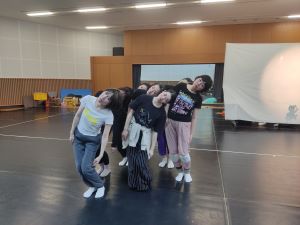
Indeed, monkeys communicate and socialize a lot through contact and touch. It is not uncommon to find a group of monkeys huddled together. In many species, the higher a monkey is in the group’s hierarchy, the more it seeks physical contact with others. This exercise proved useful in working on the monkey chorus in the early stages, and I was happy to see that it had been adapted and developed in different ways by the monkey team to experiment with group movement mechanics.
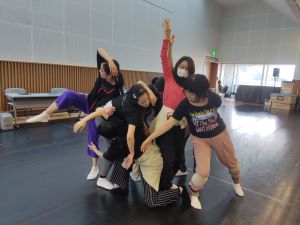
The monkey team then conducted extensive research on monkeys’ behavior and way of life. They watched videos of monkeys and tried to replicate their movements. They made drawings to better observe and understand the shape of their bodies. They also researched their way of life and, from there, began working on the psychology of the characters. With great ingenuity, they also built flexible tails that could be manipulated with a fishing line attached to their hand. The tail created interesting movement constraints that the actors enjoyed playing with.
It was also a question of deciding how much humanity the monkeys should have. Should they be played in a simian and caricatured way? Are they hybrid beings, half-human, half-monkey? Or are they a human species that happens to have a tail?
Personally, I think a naturalistic representation is not very interesting for performance research. It would be merely a form of imitation that wouldn’t allow for the exploration of more imaginative movements. It would also confine the audience within the familiar image of an animal they already know. Moreover, it would not be innovative, as many theater companies have already explored this approach extensively.
What I find interesting is playing with the “theatrical pact”. That is to say, if you tell the audience, while showing them a pen, that this is a cow—even if the pen has nothing to do with the appearance, posture, or gestures of a cow—within the theatrical framework, the audience will make the effort to believe it and see a cow. But it won’t be a cow imposed on them; it will be THEIR cow—the cow they choose to see in that pen. Each person will see a different cow.
Similarly, if you tell the audience that this character is a monkey, no matter how you represent them, the audience will see a monkey. So why not play with the audience’s imagination by presenting them with unconventional monkeys? What could this create in their imagination if the monkeys moved more like spiders or elephants, for example? Or if the monkeys behaved entirely like human beings, with the only distinction being that they had a tail?
Now, I would like to ask you, dear reader: how would you have represented the monkeys if you were an actor in this play?
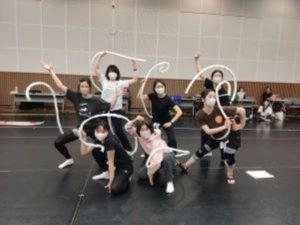
Janelle RIABI
Ramayana
https://festival-shizuoka.jp/en/program/ramayana/
Dates: 29 April at 18:45, 2 May at 18:45, 3 May at 18:45, 4 May at 18:45, 5 May at 18:45, 6 May at 18:45
Venue: Momijiyama Garden Square, Sumpu Castle Park
Duration: Approx 90minutes
Language: In Japanese with English surtitles
*Information about surtitles in other languages will be announced later.
Seat: Reserved-seating
Original work: Valmiki
Structure and direction: MIYAGI Satoshi